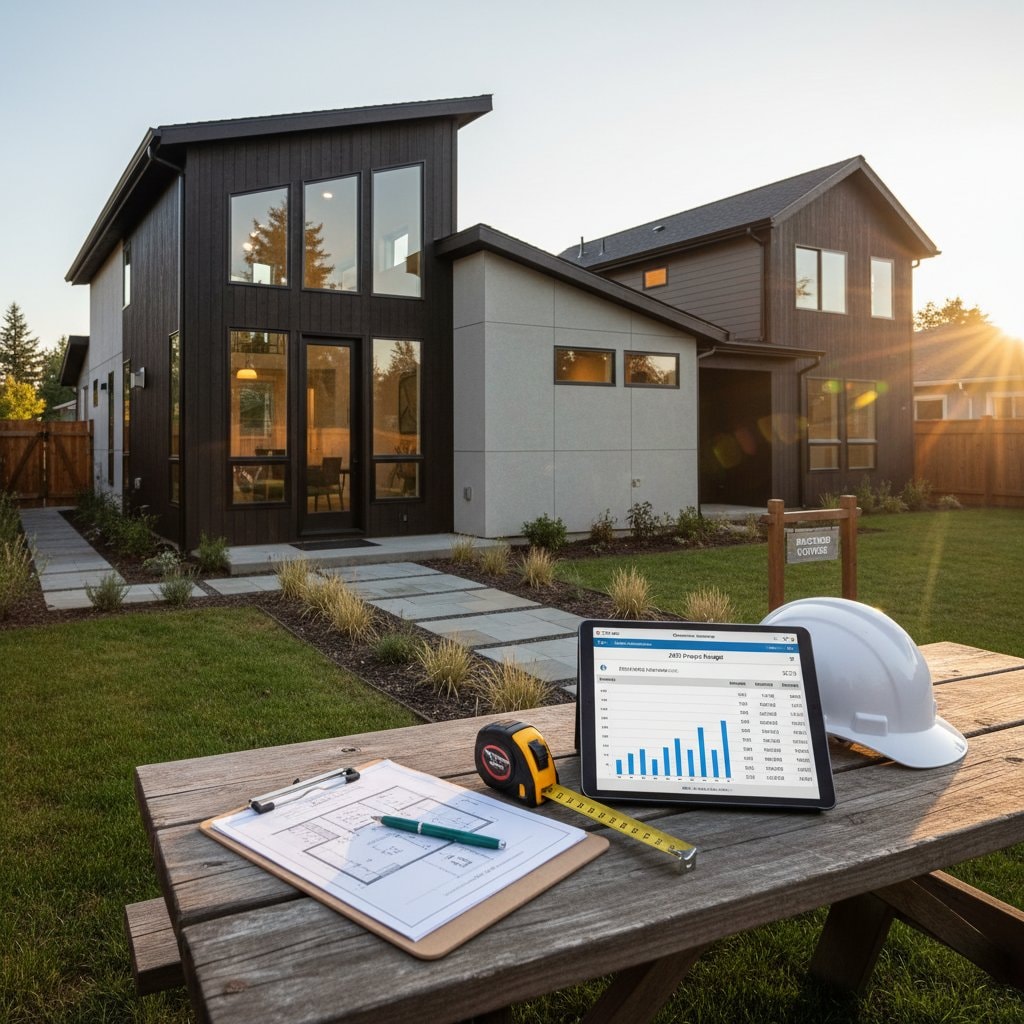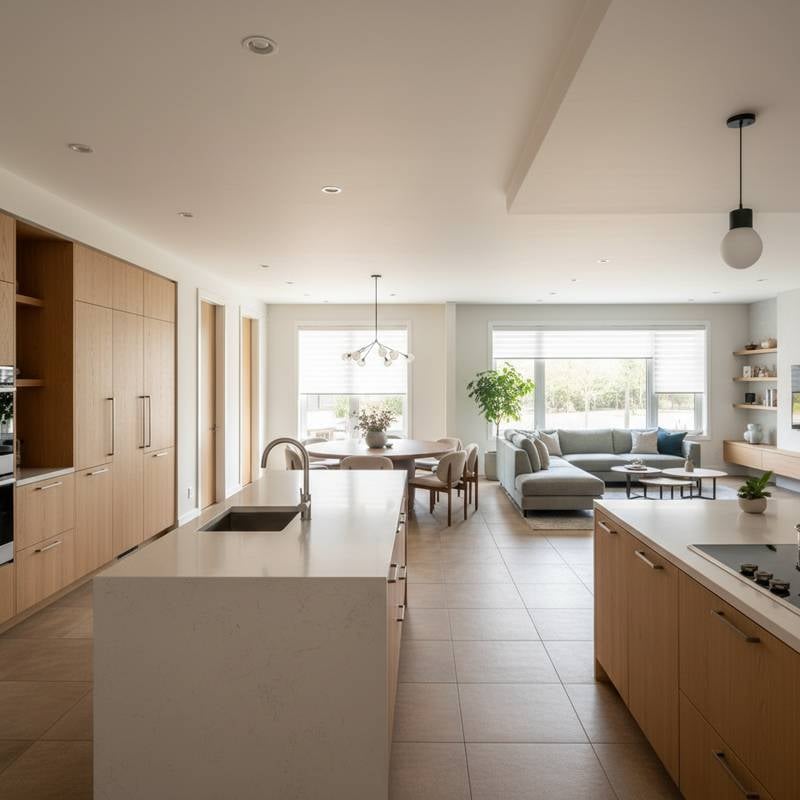Projected Duration:
- Owner-Led Builds: Span 8 to 12 months, varying with skill level and time commitment.
- Contractor-Managed Projects: Last 4 to 8 months, contingent on team capacity and approval processes.
Project Complexity: High. ADU development requires coordination among trades, adherence to regulations, and multiple evaluations.
Owner Involvement Versus Expert Assistance
Scenarios for Owner Participation
Individuals with building experience may oversee select phases using appropriate equipment. Suitable tasks include:
- Applying interior paint, laying flooring, and installing trim.
- Handling site landscaping and straightforward exterior applications.
- Fitting basic elements such as faucets and light fixtures.
Necessity of Licensed Experts
Engage certified specialists for foundational, electrical, and plumbing elements. A general contractor oversees integration of these components while upholding standards. Mandatory professional involvement covers:
- Establishing foundations and erecting frames.
- Routing electrical systems and linking to primary panels.
- Configuring plumbing networks and connecting to drainage.
- Setting up heating, ventilation, and air conditioning with associated ducting.
Expense Analysis
- Owner-Handled Elements: Potentially reduce labor costs by 5 to 10 percent through completion of finish work.
- Complete Contractor Service: Averages $250 to $500 per square foot, adjusted for regional rates and quality levels.
Experts also navigate approvals, evaluations, and timelines, minimizing disruptions and liabilities.
Detailed Construction Sequence
1. Initial Planning and Design
Consult an architect or designer versed in regional ADU regulations.
- Develop comprehensive floor plans and exterior views.
- Incorporate provisions for water, sewage, and electrical services.
- Verify compliance with spacing, elevation, and vehicle accommodation rules.
Validation Point: Designs align with zoning and construction codes prior to filing.
2. Securing Approvals
Present plans to the municipal building authority.
- Cover fees for reviews and environmental impacts.
- Arrange preliminary inspections.
Validation Point: Obtain endorsed plans authorizing construction commencement.
3. Preparing the Site
Eliminate obstacles and ensure even ground.
- Dismantle existing features or clear foliage.
- Delineate foundation boundaries and service pathways.
Validation Point: Area stands cleared, stabilized, and prepared for base work.
4. Establishing the Base
Select slab-on-grade, crawlspace, or elevated support systems.
- Assess ground composition prior to concrete placement.
- Apply vapor barriers and secure fastening elements.
Validation Point: Base achieves uniformity and clears preliminary review before proceeding.
5. Structural Framing
Assemble vertical supports, roof assemblies, and decking.
- Employ treated wood for ground-contact components.
- Affix roofing layers and reinforcement bracing.
Validation Point: Framework maintains alignment and precision in all apertures.
6. Preliminary Systems Installation
Position wiring, piping, and climate control prior to enclosing.
- Select appropriate wire sizes and certified connectors.
- Conduct pressure evaluations on water lines before concealment.
Validation Point: Infrastructure passes intermediate assessments before wall coverings.
7. Thermal Barriers and Wall Covering
Incorporate insulation compliant with efficiency standards.
- Options range from batted fiberglass and foam applications to solid panels.
- Secure and refine drywall joints for seamless results.
Validation Point: Surfaces prepare evenly for coatings, free of imperfections.
8. Internal Completions
Fit flooring, storage units, moldings, and appliances.
- Prime surfaces followed by two layers of finish paint.
- Secure entryways, glazing, and lower trim.
Validation Point: Applications align properly, mechanisms function, and installations operate as intended.
9. External Applications
Apply cladding, coatings, and overhead protection.
- Seal connections and weatherproofing to avert moisture entry.
- Position drainage channels and extensions.
Validation Point: Perimeter resists elements and harmonizes with primary residence aesthetics.
10. Concluding Evaluation
Arrange terminal review with authorities.
- Verify operational integrity of all features in advance.
- Supply necessary records to evaluators.
Validation Point: Secure certification for habitation and legal utilization.
Essential Safety Measures
- Electrical Precaution: Disconnect power sources prior to any circuit handling.
- Elevation Caution: Employ secure platforms and restraints for high-level tasks.
- Personal Protection: Utilize hand coverings, eye shields, and reinforced footwear.
- Subsurface Verification: Identify buried conduits before excavation.
- Ignition Prevention: Maintain fire suppression tools during thermal operations.
Issue Resolution and Verification Protocols
Issue: Irregular Base Settlement.
Resolution: Adjust levels pre-framing using calibrated instruments for exactness.
Issue: Post-Test Fluid Escapes.
Resolution: Secure connections and repeat evaluations before enclosure.
Issue: Inadequate Climate Regulation.
Resolution: Confirm conduit dimensions and circulation patterns.
Verification Steps:
- Confirm verticality and orthogonality of partitions.
- Ensure proper liquid evacuation from basins and enclosures.
- Validate circuit responses during simulated overloads.
Debris Management
- Evacuate waste materials and clean all areas.
- Repurpose metals, timber, and paper products where feasible.
- Handle concrete remnants, wallboard, and coatings per municipal guidelines.
- Reestablish greenery affected by activities.
Effective management avoids runoff issues and boosts visual appeal.
Ongoing Care and Durability
Conduct yearly examinations for deterioration.
- Inspect overhead coverings for breaches or displacements.
- Refresh outer coatings every 5 to 10 years based on environmental factors.
- Maintain climate systems with periodic servicing and media replacement.
- Routinely activate detection devices for smoke and gases.
Robust building practices paired with regular upkeep support longevity exceeding 50 years.
Indicators for Expert Intervention
Seek professional aid when:
- Alterations affect load-bearing elements or bases.
- Modifications involve power, water, or fuel distribution.
- Discover contaminants like mold, hazardous fibers, or moisture intrusion.
Expert Fee Spectrum:
- Overall management: 10 to 20 percent of total expenditure.
- Specialized services (piping, circuits, climate): $80 to $200 hourly.
Selection Criteria:
- Confirm credentials and coverage.
- Solicit endorsements and visual portfolios.
- Demand documented assurances for work and supplies.
- Examine billing progression and modification procedures prior to agreement.
Strategies for Optimal Outcomes
- Allocate 10 percent reserve for unforeseen expenditures.
- Validate all approval and review obligations upfront.
- Opt for resilient, care-minimal substances to curb future costs.
- Document transactions, designs, and endorsements meticulously.
- Maintain consistent dialogue with oversight personnel to adhere to timelines.
A thoughtfully executed ADU enhances property worth, adaptability, and revenue streams. Through precise financial planning, regulatory adherence, and skilled execution, achieve a resilient space that satisfies codes and elevates residential utility.











